Korean Spinach Banchan (Two Ways)
Spinach banchan is a classic Korean spinach side dish, commonly served in Korean cuisine. There are two variations of this delicious recipe, one made with soy sauce and the other with gochujang. You can learn how to make both versions and decide which one you prefer. A video tutorial is also included.
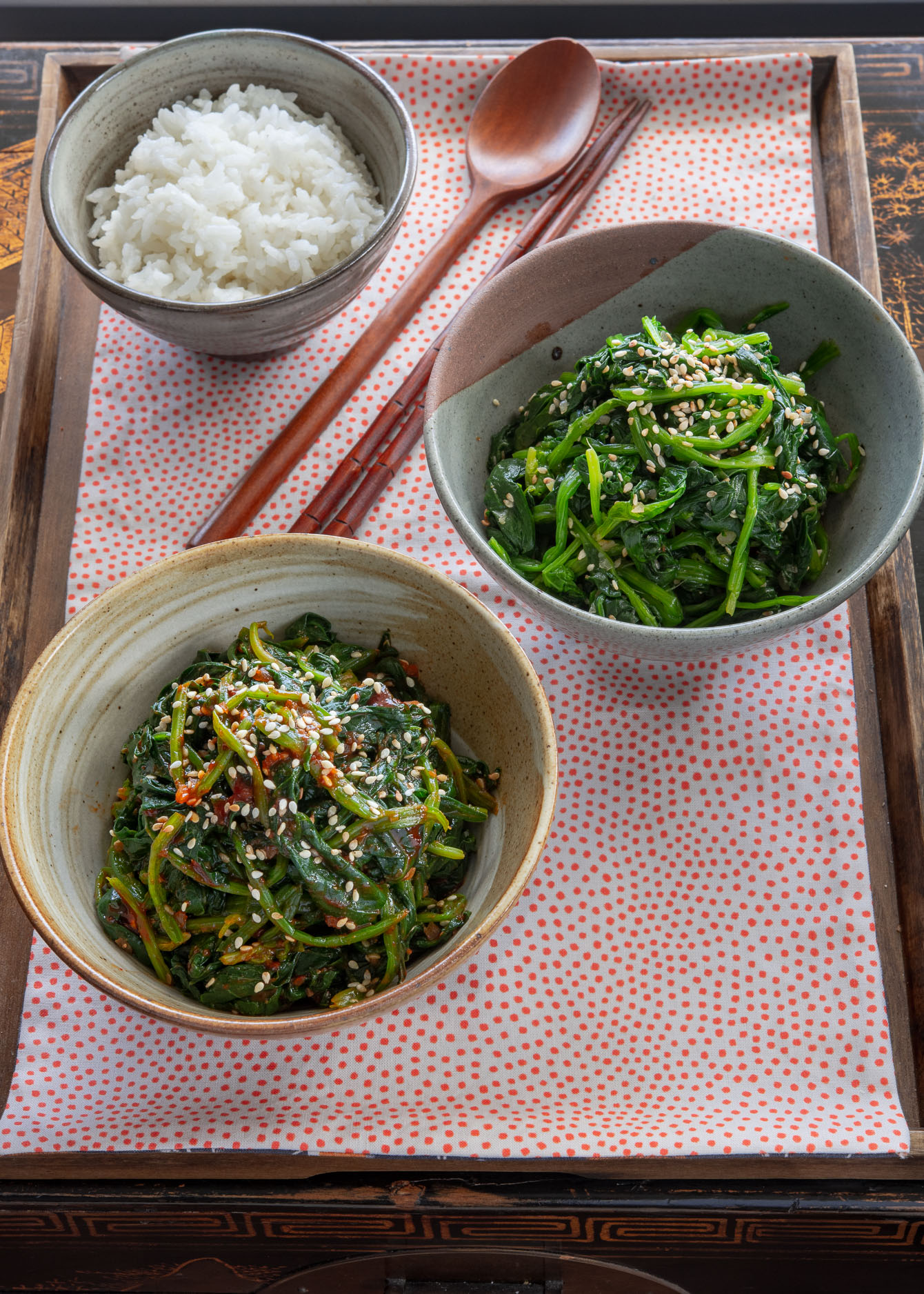
Korean cuisine is renowned for its wide variety of side dishes, known as banchan. Korean dinner tables often feature the popular dish sigeumchi namul (시금치나물), a spinach side dish, along with a bean sprout side dish, among the many delicious options.
This dish is typically prepared by blanching the spinach, squeezing out any excess water, and then mixing it with two different seasoning ingredients.
Korean Spinach Two Ways: Classic and Spicy
In Korean cuisine, namul (나물) refers to a type of seasoned vegetable dish served as banchan (Korean side dishes), which uses mixture of various sauces.
Spinach namul, also known as sigeumchi namul, is not only delicious but also easy and quick to make. Here are two variations that you can try:
- Classic sigeumchi namul: This is the most common Korean spinach recipe using Korean soup soy sauce (gukganjang) and sesame oil.
- The classic recipe is a great base for making the famous Korean rice bowl with vegetables (aka Bibimbap)!
- Spicy sigeumchi namul: This version has a slightly spicy taste and a robust flavor due to the addition of Korean chili paste (gochujang) and a hint of Korean soybean paste (doenjang).
- The spicy version originates from Gyeonsang province in South Korea, which is my hometown. Although many other Koreans love to make their spinach this way, it is often regarded as a local favorite. This recipe is my mother’s, and I always loved it.
I will share both recipes for a delicious and simple Korean style spinach salad. I recommend that you try both recipes and see which one you like better.
How to clean a bunch of spinach
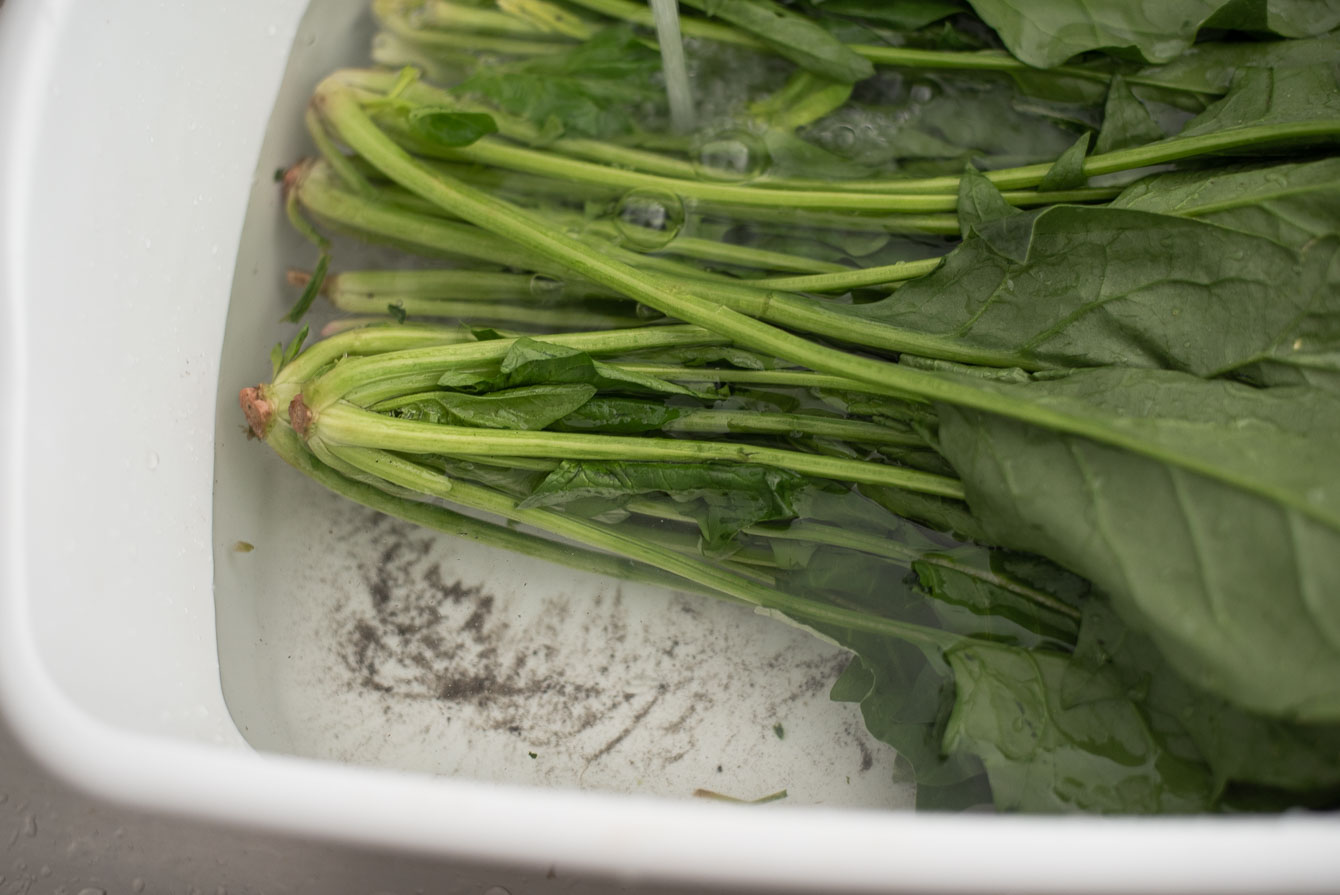
Whole spinach bunches can trap a lot of dirt inside, so it’s essential to clean them properly.
The best way to do this is by immersing the bunches in water for about a minute, allowing the dirt to sink to the bottom of the bowl. Be sure to use a bowl large enough to hold the entire spinach bunch.
Then, drain and rinse the spinach a couple of times more to ensure thorough cleaning. Finally, put the cleaned spinach in a colander to remove any excess water.
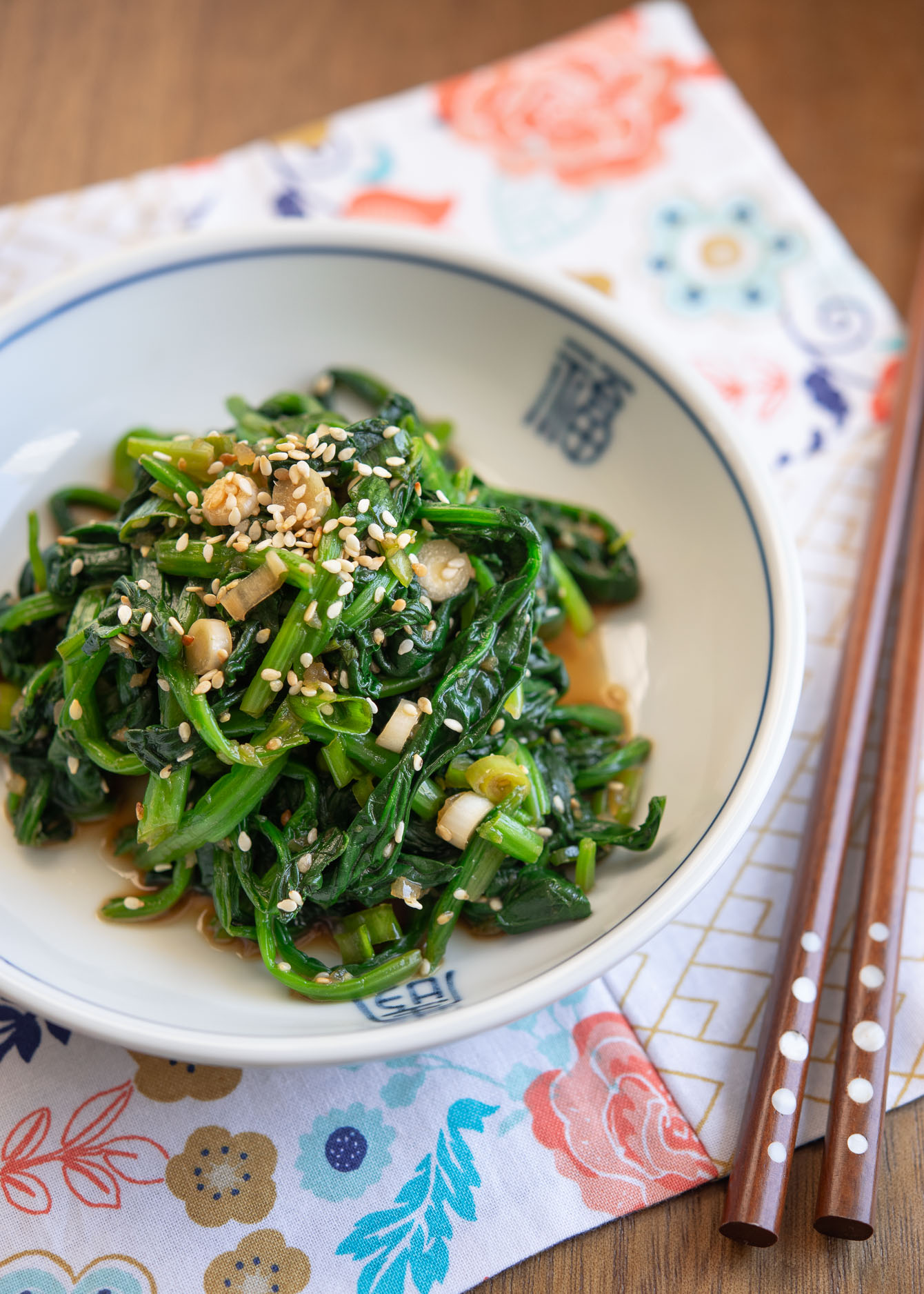
1. Classic Korean spinach
The classic version of spinach side dish uses Korean soup soy sauce, which gives it a lighter, milder taste while providing a deeper flavor. If you don’t have Korean soup soy sauce available, you can replace it with regular soy sauce.
Ingredients for classic version
- A bunch of fresh spinach: This leafy green vegetable packs nutrients and refreshes the dish with its flavor.
- Korean soup soy sauce (gukganjang): This savory and slightly salty sauce is made from fermented soybeans and gives the dish its signature umami flavor.
- Garlic: Adds a pungent aroma and depth of flavor to the dish.
- Sesame oil: Provides a nutty and fragrant taste that complements the spinach and other ingredients.
- Toasted sesame seeds: These crunchy and nutty seeds add texture and enhance the dish’s overall flavor.
- Green onion: Adds a fresh and slightly sweet taste to the dish, while also providing a pop of color.
How to make classic spinach namul
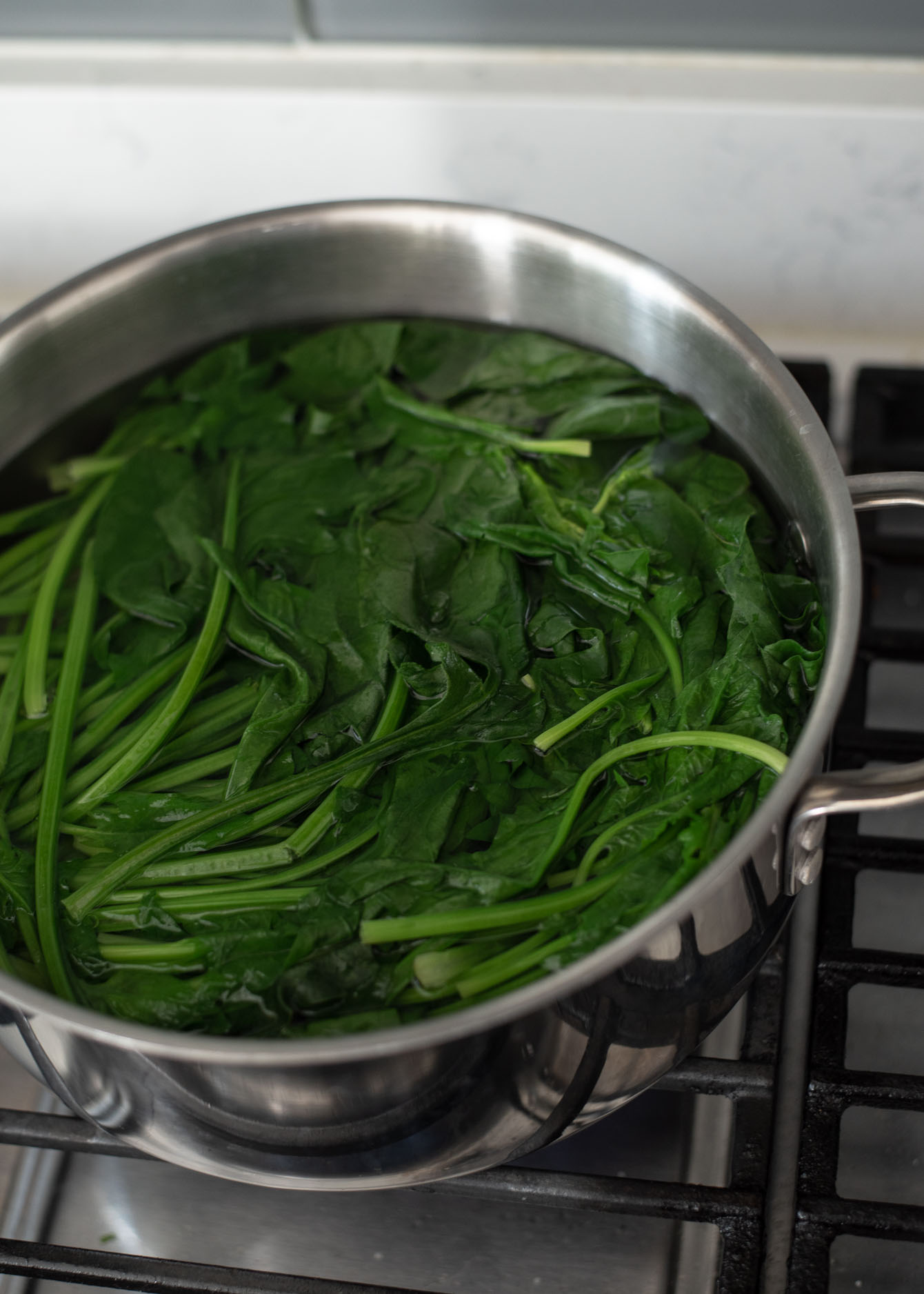
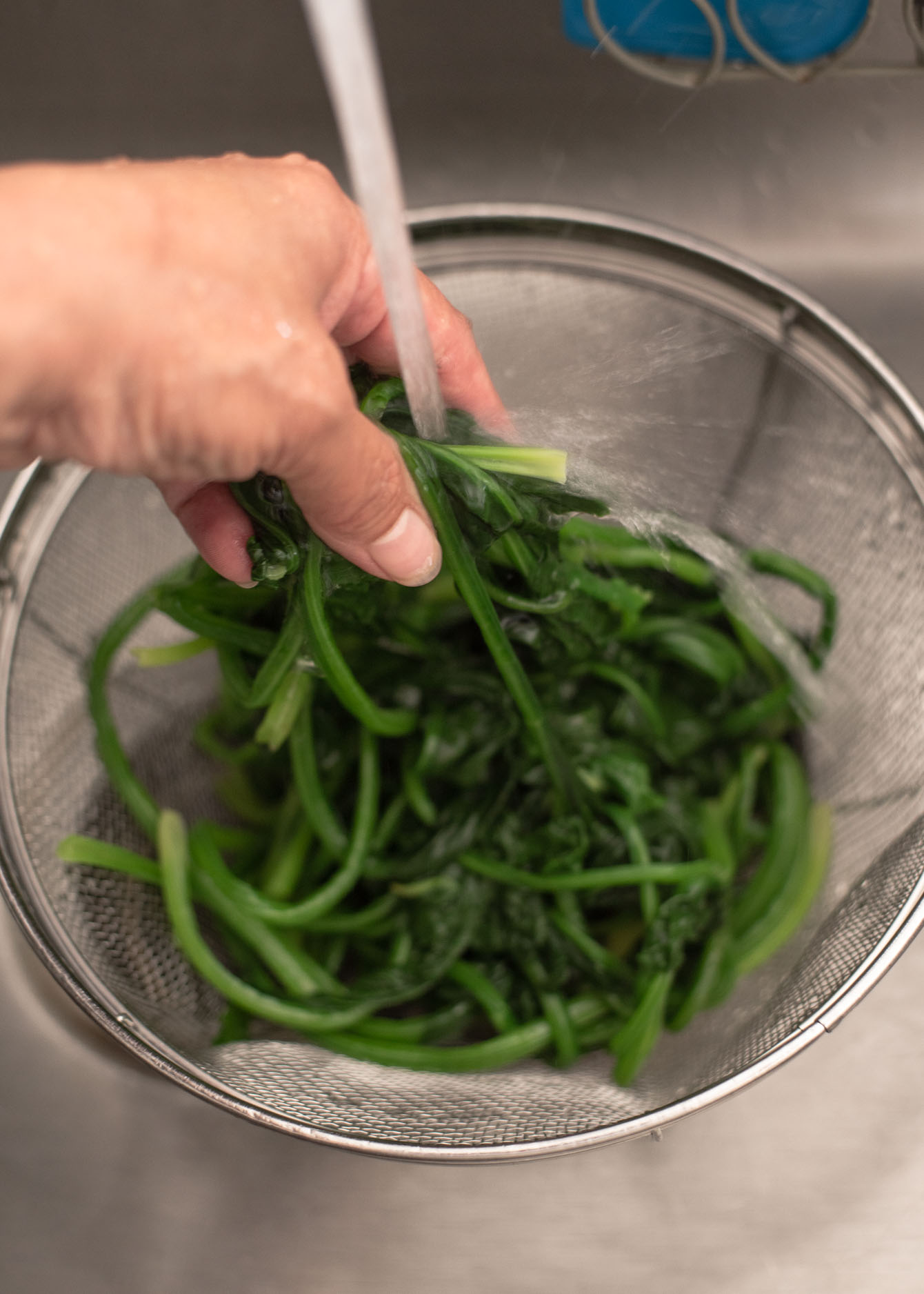
Step 1. Bring a pot of water to boil, then add some salt and the spinach. Blanch for 30 seconds, then drain the spinach in a colander. Next, cool the spinach by rinsing it under cold water until it has lost all its heat.
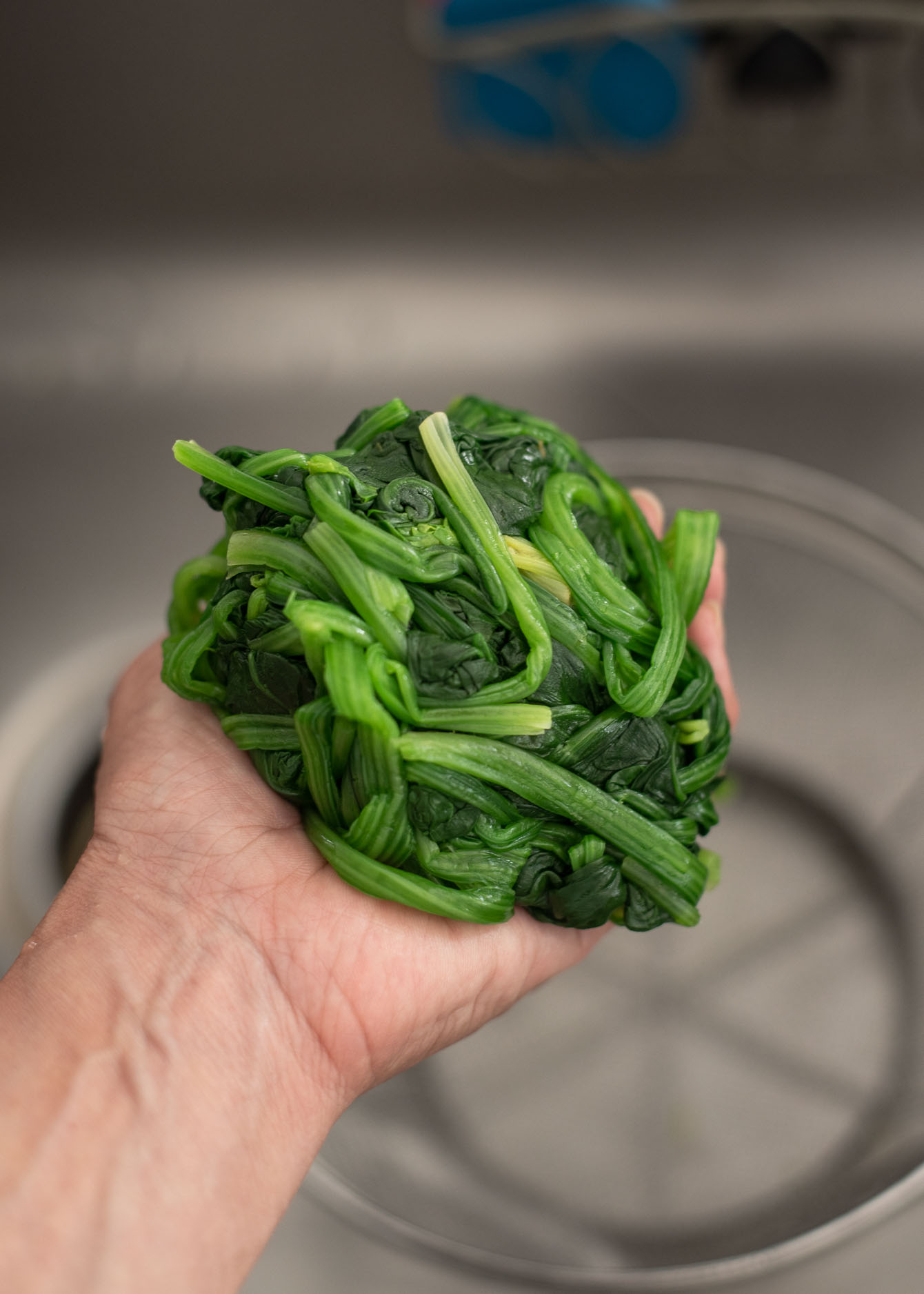
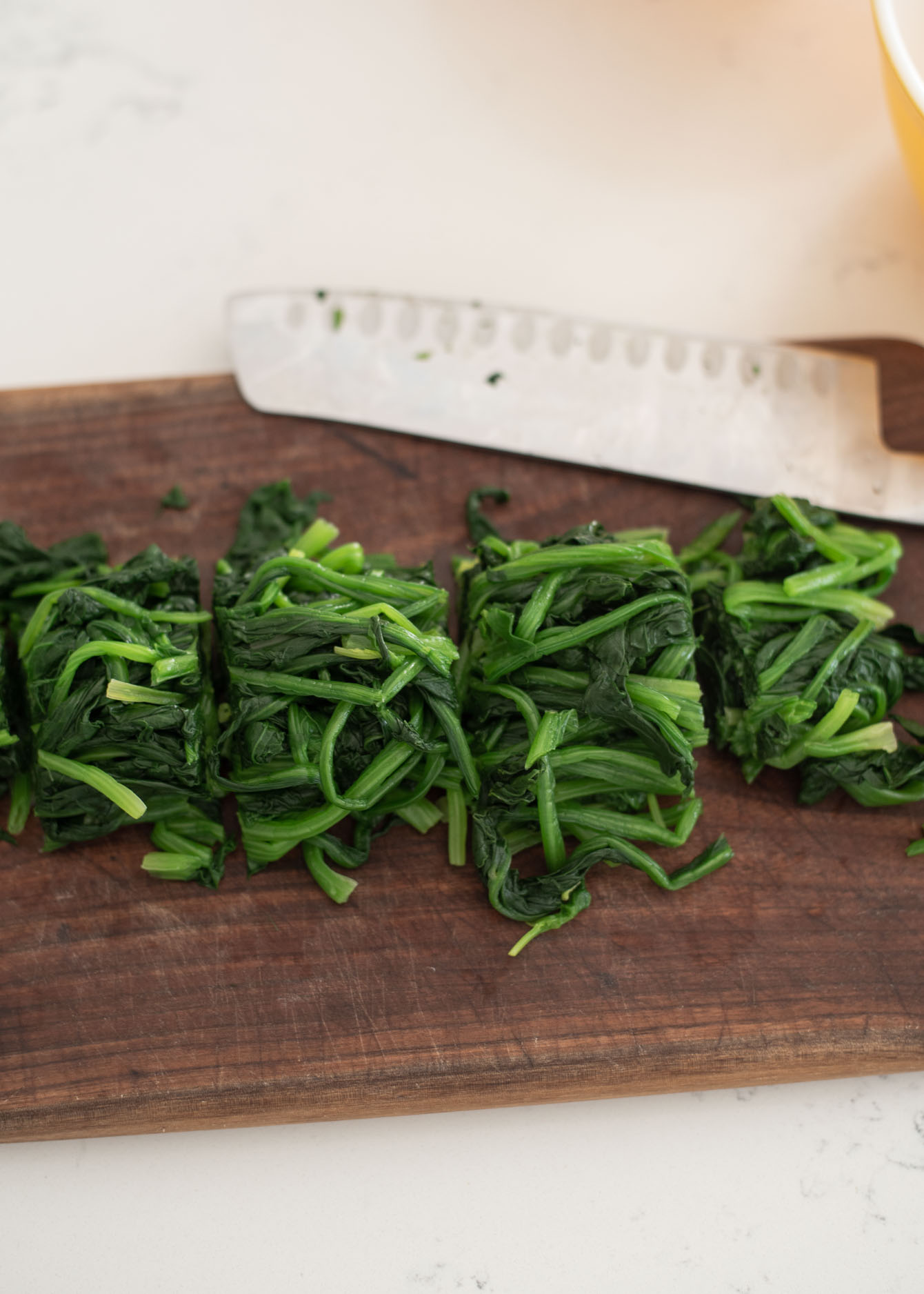
Step 2. Squeeze the spinach firmly to remove excess water. Place spinach on the cutting board and cut the spinach into 3-inch long pieces.
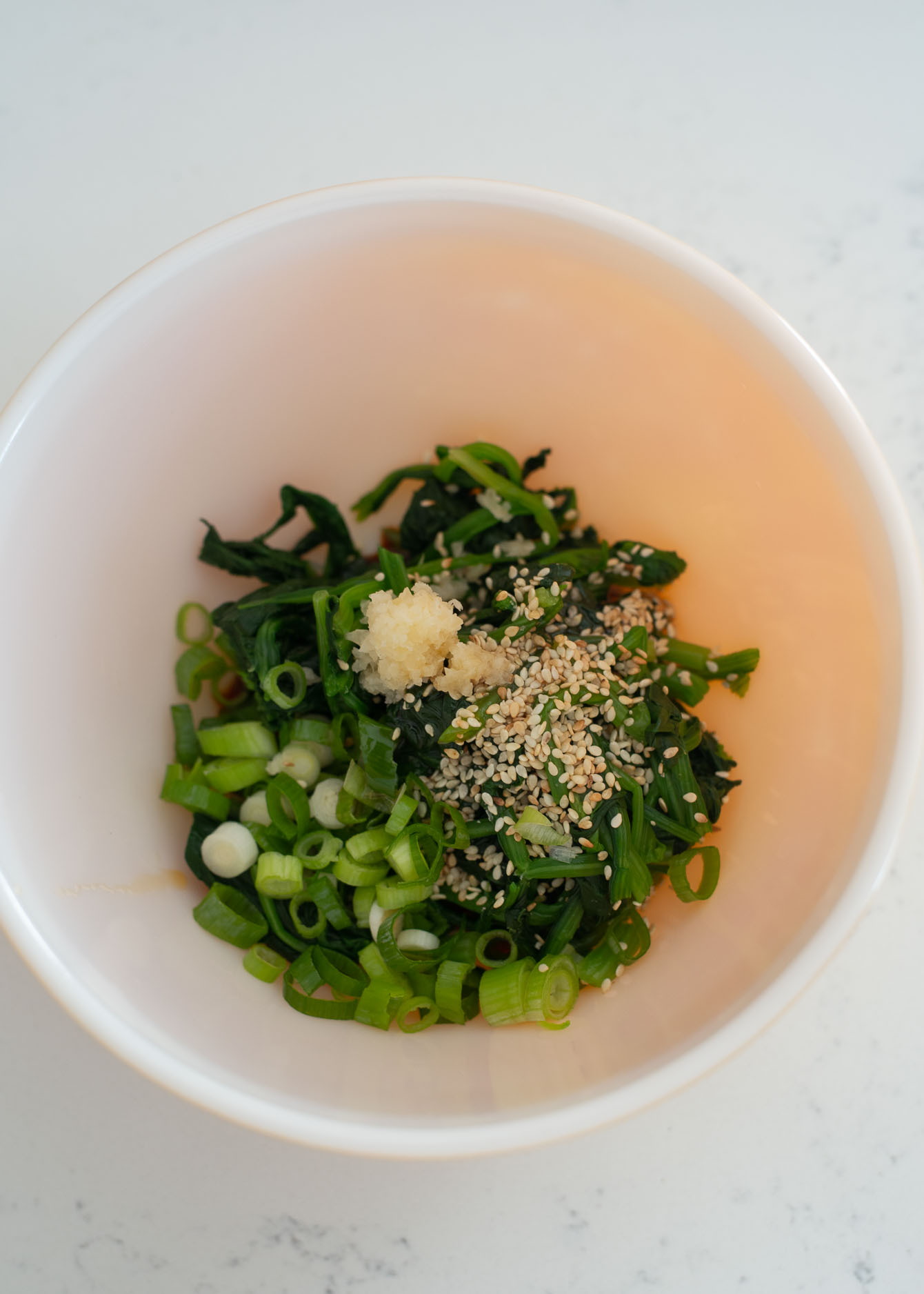
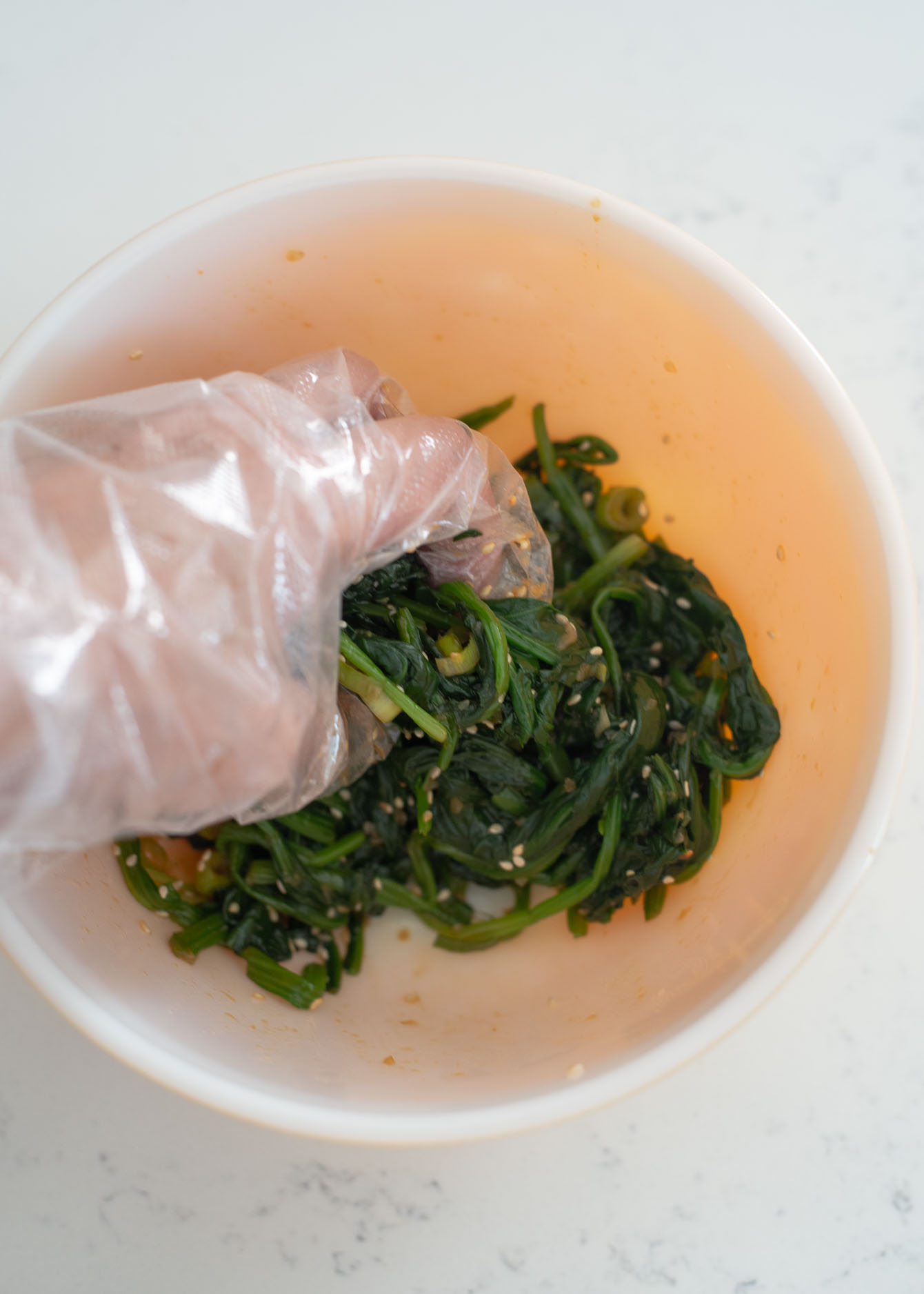
Step 3. Place them in a medium mixing bowl. Add Korean soup soy sauce, garlic, sesame oil, and sesame seeds. Toss with your hand to incorporate the seasoning into the spinach. Watch my video tutoria to see how I do it.
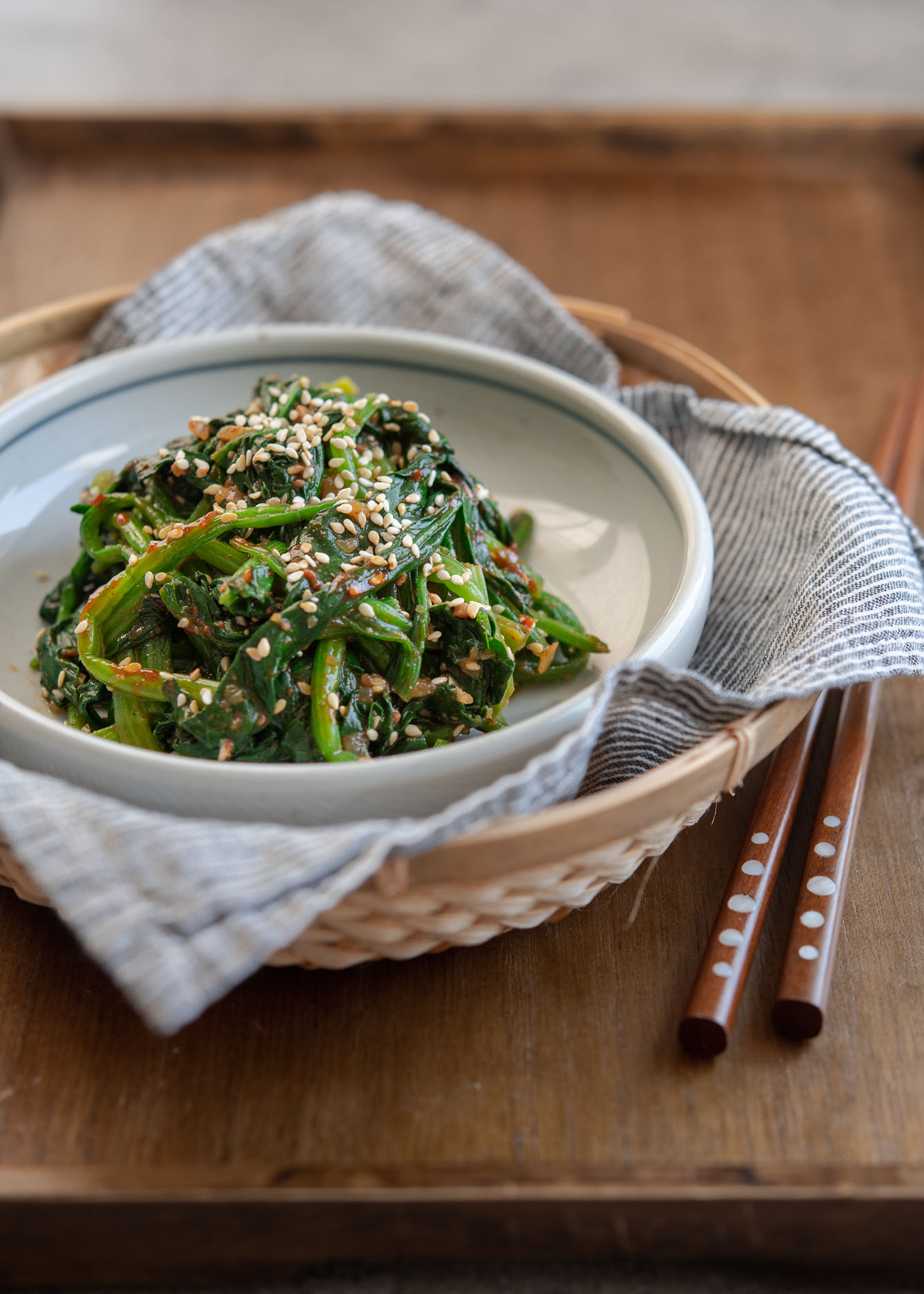
2. Spicy Korean spinach
This version of shigeumchi namul uses gochujang (Korean chili paste) mixed with a hint of doenjang (Korean soybean paste). Each condiment adds a deep umami taste that makes this dish truly authentic to Southern Korean cuisine.
Ingredients for spicy version
- A bunch of fresh spinach: This leafy green vegetable is a great source of vitamins and minerals and adds a fresh and earthy flavor to the dish.
- Korean chili paste (gochujang): This paste made from red chili peppers, rice, and fermented soybeans adds a spicy kick and depth of flavor to the dish.
- Korean soybean paste (doenjang): This paste made from fermented soybeans and rice adds a rich and savory taste to the dish.
- Garlic: Adds a pungent and slightly sweet aroma and flavor to the dish.
- Sesame oil: This fragrant and nutty oil is a staple ingredient in Korean cuisine and adds a rich and toasty taste to the dish.
- Toasted sesame seeds: These crunchy and nutty seeds provide a delicious and aromatic flavor, as well as a pleasant texture to the dish.
How to make spinach namul with gochujang
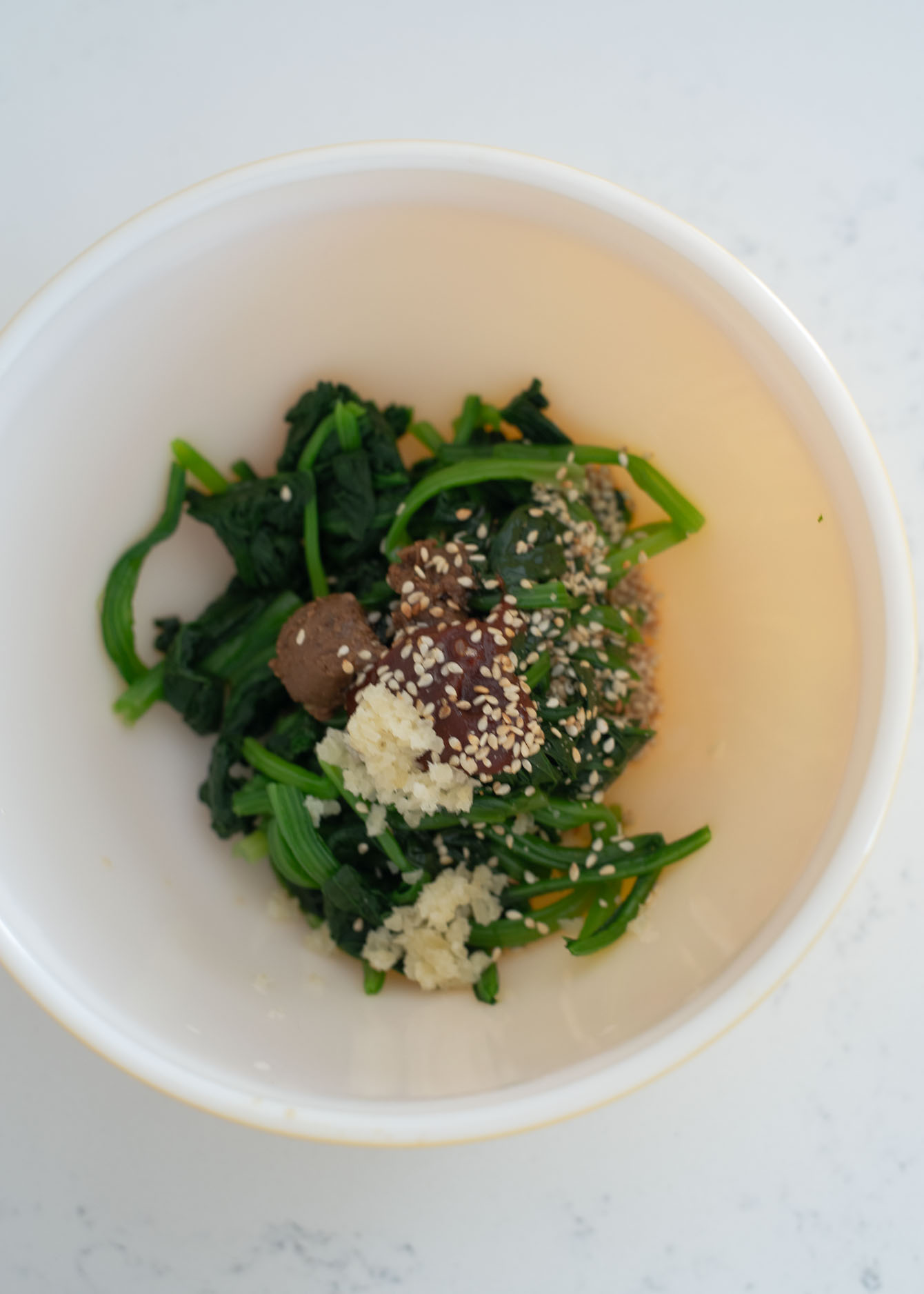
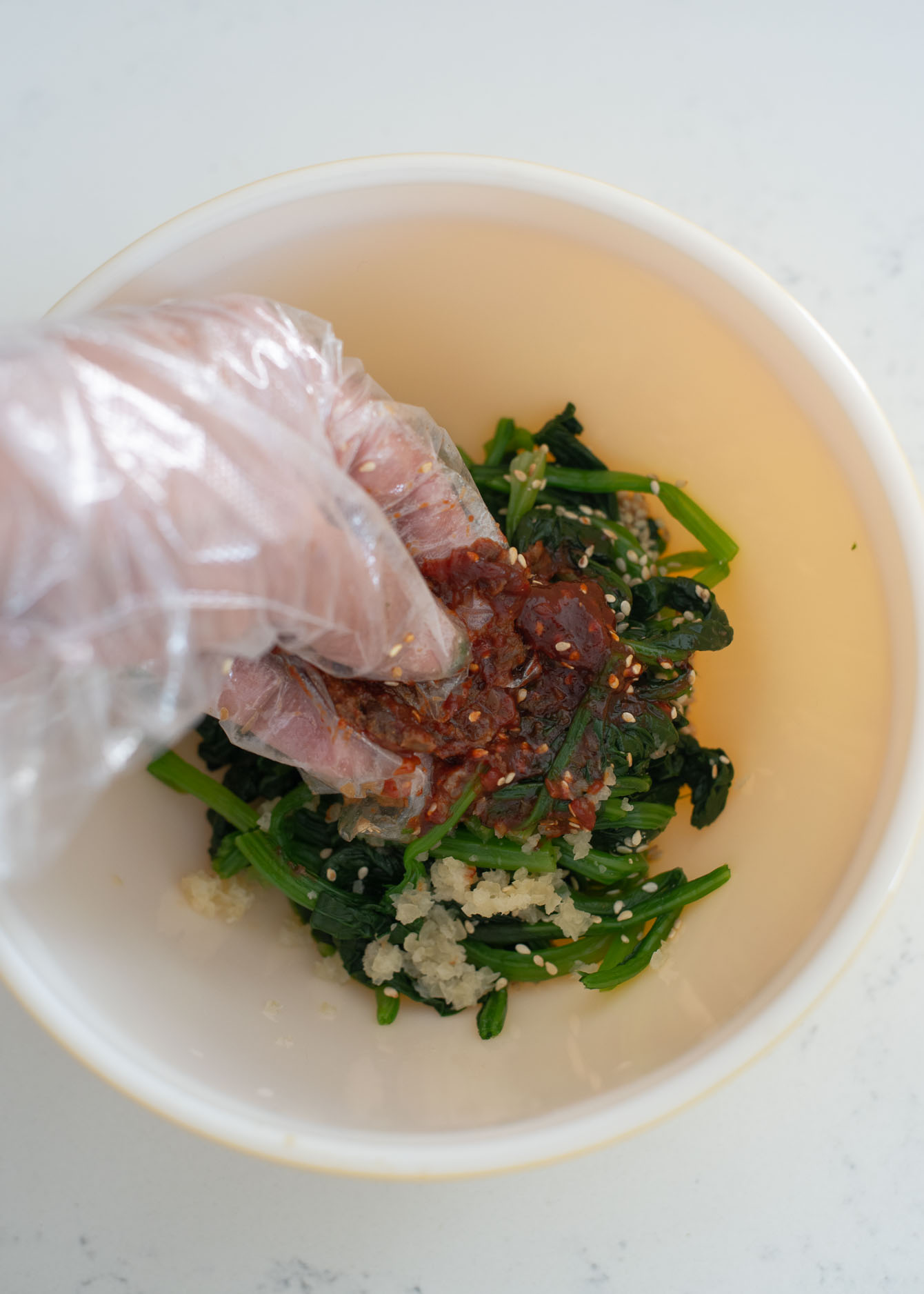
Step 1. Blanch the spinach following the instructions above (step 1 and 2). Cut and place them in a mixing bowl.
Step 2. Add gochujang, doenjang, garlic, sesame oil, and sesame seeds. Smear the Korean pastes with your fingers and toss with the spinach to incorporate the seasoning. Watch my video tutorial as a reference.
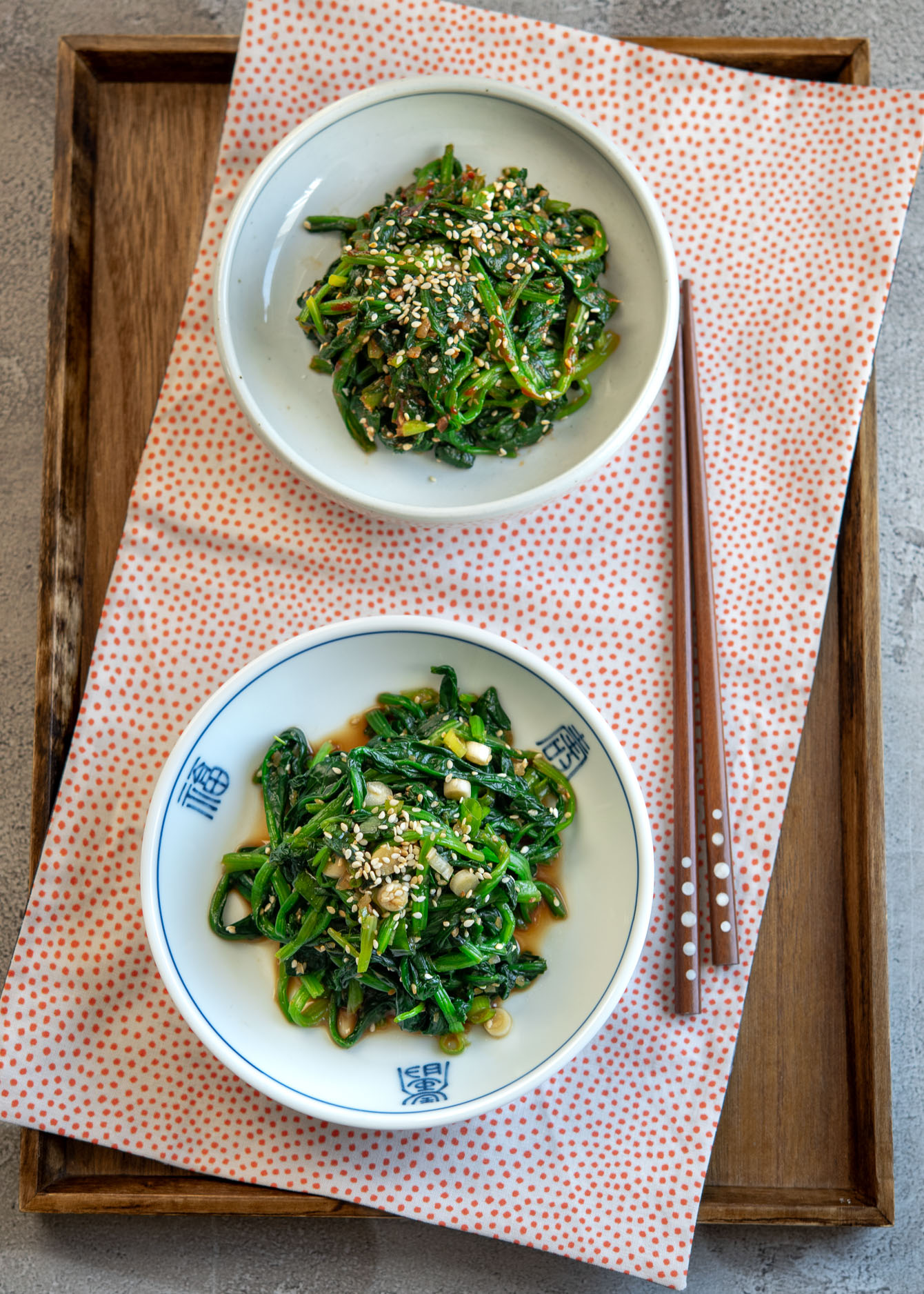
Dishes to pair with Korean spinach banchan
Spinach banchan pairs well with a variety of Korean main dishes and other Asian main dishes. Here are some of my personal favorites:
- Beef Bulgogi (Korean BBQ Beef): This savory and slightly sweet Korean-style grilled beef is a classic dish that complements the refreshing taste of the spinach banchan.
- Spicy Pork Bulgogi (Jeyuk Bokkeum): This spicy and flavorful Korean pork dish is a popular favorite that adds a kick of heat to the meal.
- Korean Braised Beef Short Ribs (Galbi-Jjim): This tender and succulent braised beef dish is a hearty and satisfying pairing for the spinach banchan.
- Ground Beef Bulgogi (Korean Ground Beef): This quick and easy Korean-style beef bowl is a delicious and convenient way to enjoy the flavors of Korean cuisine.
- Broiled Red Snapper with Korean Chili Sauce: This fresh and flavorful fish dish is a light and healthy pairing for the spinach banchan, with a spicy kick from the Korean chili sauce.
Storage tip
Store in a container in the refrigerator for up to 1 week. You can serve them chilled right out of fridge. Do not freeze. This dish doesn’t freeze well.
5 Must-Try Korean Side Dishes:
- Microwave Soft Tofu: Easy and comforting Korean tofu side dish that is soft and silky, with a delicate flavor that pairs well with many main dishes.
- Korean Potato Side Dish (Gamja Jorim): sweet and savory potato dish that is braised in a soy sauce-based sauce and flavored with garlic, ginger, and other spices.
- Korean Dried Anchovy Side Dish (Two Recipes): Versatile Korean side dish that features two different recipes showcasing the delicious and umami flavor of dried anchovies.
- Crispy Korean Pan-Fried Tofu (Dubu Buchim): Crispy and flavorful tofu dish that is pan-fried to perfection, with a savory and slightly spicy sauce that complements the crispy exterior.
- Korean Bean Sprout Side Dish (Kongnamul Muchim): Refreshing and crunchy bean sprout side dish that is seasoned with a light and tangy dressing, bringing out the natural flavor of the sprouts.
I first published this post in Feb, 2012 and have since updated it with additional write-up, images, and a video.
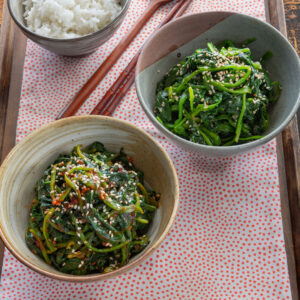
Korean Spinach Banchan (Two Ways)
Recipe Video
Ingredients
For classic spinach banchan
- 1 bunch spinach, cleaned
- 2 tsp Korean soup soy sauce (gukganjang), or 1 tbsp soy sauce
- 1 clove garlic, finely minced
- 2 tsp sesame oil
- 2 teaspoon toasted sesame seeds
- 1 green onion, finely chopped
For spicy spinach banchan
- 1 bunch spinach, cleaned
- 2 tsp Korean chili paste (gochujang)
- 1 tsp Korean soybean paste (doenjang)
- 1 clove garlic, finely minced
- 2 tsp sesame oil
- 2 tsp toasted sesame seeds
Instructions
To clean and blanch the spinach
- Bring a pot of water to boil. Add some salt and the spinach to the water; blanch for 30 seconds. Drain the spinach in a colander and rinse under cold water until all the heat from the spinach has been cooled. Squeeze the spinach firmly to remove excess water. Place spinach on the cutting board and cut the spinach into 3-inch long pieces.
To make classic spinach banchan
- Put spinach in a mixing bowl. Add Korean soup soy sauce (or soy sauce), garlic, sesame oil, and sesame seeds. Toss with your hand to incorporate the seasoning into the spinach.
To make spicy spinach banchan
- Put spinach in a mixing bowl. Add gochujang, doenjang, garlic, sesame oil, and sesame seeds.
- Smear the Korean pastes together with your fingers to mix them first, then toss everything together to incorporate the seasoning into the spinach.


Oh my! I’ve always loved spinach but this is a different level. Gotta admit, I preferred the gochujang version.
I Like gochujang version as well. Glad that you like it. Thanks!
This delicious-looking recipe just showed up on Yummly, so I’m going to bookmark it.
How similar is doenjang to miso? I have miso and gochujang in my refrigerator at the moment.
You can substitute with miso in place of doenjang. It should work fine.
Great! Thanks for the quick reply.
Hi,, nice to find ur recipe!! I’m Indonesian and I can not find the chili paste here. Any idea?
Hi, I would like to know, I saw that Korean always hv plenty of side dishes in every meal time. Some are prepared before and kept in refrigerator. Could u please tell me what are those side dishes that can be kept for long time in refrigerator? Does spinach one of them? What I knew that spinach hv to be eaten when it’s fresh. Thanks in advance.
Spinach can last in the fridge for a week. Any Korean side dish made with fresh vegetables can last about a week in the fridge. Some made with dried or preserved can last whole lot longer.
mmmm I love spinach! This looks like a great recipe! Will be making it soon!
Thanks Holly, do you think i can use this recipe for cucumber instead? Haven't seen this type of spinach!
That is one perfect looking garlic bulb!
Really like this blog! And I also love the way you take photos of your food! 🙂
FFW.
– the Lukas
I love your step by step pics and again another yummy recipe!
ooh I love this! I think I actually prefer this rustic version, it sound spacked with flavour and hearty goodness!
I love spinach great post
I cannot wait to try it, you make cooking look so simple.
what if I have a cat ? Can my cat have your mice ?
can we request food?I started a blog in december the link is http://www.letswatcheverything.com. It is pretty much based on entertainment. I have all the latest movies that are out in theatres, tv shows, awards, video games, music and software. I have noticed that my traffic as incereased a little bit but not as much as i want it too. I been reading around and people have been saying the best way to get more traffic is to post on other blogs which will help any person out. Your article is very good. Thank you for taking the time to share with us.
I love your step by step pics and again another yummy recipe!
I like doenjang in my namul dishes as well. Your spinach looks so fresh, and the dish looks delicious!
Thank you Gria. Korean side dishes are really appetizing and most of them are quite healthy. Hope you can start making Korean food at home.
Thank you. Cleaning vegetables and fruits with baking soda is great way to get rid of pesticides on the surface.
Thanks Erica. Vegetables from farmers markets are the best. The short spinach is far better than the longer one. Hope they still have some.
This looks delicious! I love spinach!
this look so good!
Was just missing those nice dishes I had in Seoul. This is great, will make one myself soon. Cheers! 🙂
That's really cute of you to include cute hamster in your blog. Speaking of korean spinach, I went to a korean restaurant, couple weeks ago for dinner. I ordered Galbi and sticky rice. Anyways…what I really love of this restaurant is that we got a bunch of appetizers and one of them is the kind of spinach similar to yours. I may start learning how to make korean food. Super appetizing!
Yes, It only takes a few minutes to whip this up. Hole you like it, Lucy.
wow.. thanks for sharing this ingredients, i taste it before back in japan.
Oh this sounds so tasty and something like 10-15 mins to make?! That's a yes for a weekday meal 🙂
Thank you Rowena. Mice sounds worse than hamsters. I am not a big fan of rodents.
Hope you can give this spinach a try. It is different than ordinary Korean spinach and it tastes good with rice.
Ha ha! I, too, sometimes like the banchan more than the main dish. Doenjang is made of fermented soy bean and it is quite pungent. Gochujang is Korean red chili powder mixed in rice flour. Can't alternate each other in the recipe since they are completely different.
What a great recipe! So glad I found your site. I am Korean and LOVE Korean food. 🙂
Awww…the hamsters are so cute! My son had mice so I had to get used to them. I've only known about the vinegar-in-water tip for cleaning vegetables so this tip is good to know as well. Will need to definitely restock on both of those korean pastes…I go through them fairly quick but never have time to go into Milan to buy more. Oh, and congrats on being chosen for Blogs of Note!
I've always enjoyed banchan when I visit a Korean restaurant. Sometimes I even like the banchan more than the main course I get. Your spinach side dish looks absolutely delicious!
What's the difference between and doenjang and gochujang? I always get a big box of gochujang and use it for all the Korean dishes that call for the bean paste. Thanks for sharing!
i love everything korean! and i love your blog. great tip on cleaning the veggies with baking soda. thanks.
I've never made spicy spinach namul before. I will try this sometime. 🙂
oh this looks so yummy.
what a great tip for cleaning the spinach! i'm excited to try it out soon. i saw some of this smaller variety of spinach at the farmers market last weekend–i will definitely have to go and get a few bunches! 🙂 thanks for sharing this recipe, yum!
“Unless your spinach is grown organic, you want to clean them well”
Sorry, but no: organic does mean it’s going to be free from contaminants. E.Coli and salmonella do not distinguish between organic and conventional crops.